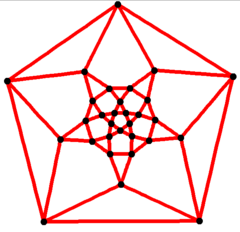Icosidodecahedron
| Icosidodecahedral graph | |
|---|---|

5-fold symmetry Schlegel diagram
|
|
| Vertices | 30 |
| Edges | 60 |
| Automorphisms | 120 |
| Properties | Quartic graph, Hamiltonian, regular |
In geometry, an icosidodecahedron is a polyhedron with twenty triangular faces and twelve pentagonal faces. An icosidodecahedron has 30 identical vertices, with two triangles and two pentagons meeting at each, and 60 identical edges, each separating a triangle from a pentagon. As such it is one of the Archimedean solids and more particularly, a quasiregular polyhedron.
An icosidodecahedron has icosahedral symmetry, and its first stellation is the compound of a dodecahedron and its dual icosahedron, with the vertices of the icosahedron located at the midpoints of the edges of either.
Its dual polyhedron is the rhombic triacontahedron. An icosidodecahedron can be split along any of six planes to form a pair of pentagonal rotundae, which belong among the Johnson solids.
The icosidodecahedron can be considered a pentagonal gyrobirotunda, as a combination of two rotundae (compare pentagonal orthobirotunda, one of the Johnson solids). In this form its symmetry is D5d, [10,2+], (2*5), order 20.
The wire-frame figure of the icosidodecahedron consists of six flat regular decagons, meeting in pairs at each of the 30 vertices.
Convenient Cartesian coordinates for the vertices of an icosidodecahedron with unit edges are given by the even permutations of:
where φ is the golden ratio, 1 + √5/2.
...
Wikipedia
